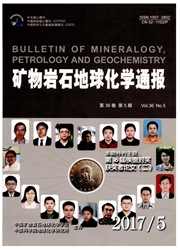

 中文摘要:
中文摘要:
为研究阪崎克洛诺菌(Cronobacter Sakazakii)还原普通钙基蒙脱石中Fe^3+的过程与机理,测定了体系中总蛋白与Fe^2+含量变化,应用同步辐射XRD(SRXRD)与X射线吸收近边结构(XANES)研究反应产物。总蛋白与Fe^2+数据表明在厌氧条件下Cronobacter sakazakii以乙酸作为电子供体,利用钙基蒙脱石中Fe^3+作为电子受体进行生长代谢,还原蒙脱石中Fe^3+形成Fe^2+。反应中蒙脱石晶体结构部分破坏,原始的d001峰消失,出现一系列与新生矿物有关的衍射峰。XANES结果显示蒙脱石中Fe主吸收峰向低能量方向移动0.5 e V,边前峰峰位中心向低能量方向移动且峰面积减小,Fe氧化态降低,蒙脱石晶体结构发生变化。研究探讨了自然界中广泛分布的钙基蒙脱石可能受到的微生物还原作用。
 英文摘要:
英文摘要:
To understand the process and mechanism of the interaction between Cronobacter sakazakii and Fe-poor Camontmorillonite,we measured the total protein and the reduction rate of Fe3+and investigated structure transformations of products by synchrotron radiation XRD and X-ray absorption near edge structure( XANES). In the logarithmic and stationary phases of bacteria growth,Fe3+in Ca-montmorillonite was reduced rapidly by bacteria and Fe2+was accumulated. Synchrotron radiation XRD of the products showed a series of new peaks while missed the original peak of d001. New minerals represented by new peaks were resulted from crystal structure damage and partial phase transition of Ca-montmorillonite.XANES results showed the main absorption peaks shifted toward the lower energy for about 0. 5 e V. The decrease of centroid energy and the integrated intensity of the pre-edge peaks meant a decrease in iron oxidation state,indicating crystal structure changes in the Ca-montmorillonite.
 同期刊论文项目
同期刊论文项目
 同项目期刊论文
同项目期刊论文
 期刊信息
期刊信息
